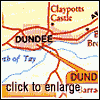|
Loch Earn and Loch Tay
At the eastern end of Loch Earn still following the
A85, St Fillans is frequently regarded as one of Scotland's best kept secrets and
another choice stopping place. The village, formerly known as Port of Lochearn, was
later called St Fillans after the Celtic missionary from Ireland called Faolan. In
the sixth century he established himself on Dunfillan or St Fillan's hill and set
about converting the local Picts to Christianity.
Here too, are water-sports and sailing although most
of the activity is based around Loch Earn Caravan Park on the south side of this
end of the loch. A more sedate site is the St Fillan's Caravan Site at the old railway
station. For an easy amble, try the relatively flat St Fillans Golf Course.
Follow the shoreline to Lochearnhead then north to
Killin on the A85. It is then possible to return to Perth along the shores of Loch
Tay on the A827. Ben Lawers is Tayside's highest mountain at 3,984ft (1,215m) and
famous for its alpine plants growing on southerly facing slopes. To find them may
not be easy but a visit to the Ben Lawers Visitor's Centre run by the National Trust
for Scotland will help you to understand this rare and special environment. Ben Lawers
has been a National Nature Reserve since 1975.
 Glen Lyon can be entered continuing past the Ben Lawers Visitor
Centre on the minor road heading north, an interesting drive over some high moorland.
It is the longest of the Scottish Glens and was Campbell country before the Clearances
but now, as with so many 'improved' glens, it caters mainly to sheep. Glen Lyon can be entered continuing past the Ben Lawers Visitor
Centre on the minor road heading north, an interesting drive over some high moorland.
It is the longest of the Scottish Glens and was Campbell country before the Clearances
but now, as with so many 'improved' glens, it caters mainly to sheep.
Set back a few miles from Loch Tay at its eastern
end is the village of Fortingall. The row of cottages are particularly enchanting,
most of them still thatched. Near the church at the east end of the village is the
Fortingall Yew. This undistinguished piece of vegetation, now split and sagging like
a badly tended and overgrown bush, is perhaps the oldest living thing in Europe.
At around 3,000 years old it was in existence during the era of the Roman Empire
and the birth of Christ.
Another surprising aspect of Fortingall is the myth
that Pontious Pilot was born here. It is said that his father was a Roman envoy sent
by Caesar Augustus to help quell the warlike activities of the Picts and he had a
child with a local woman, perhaps one of the Menzies Clan. The father returned to
Rome with his son. Later in life, Pontious returned to retire and die here in Fortingall.
The legend has been further substantiated by the discovery earlier this century,
of a large stone slab near the village bearing the initials P.P.
Kenmore
 Kenmore is one of Perthshire's activity centres. Situated
on the east end of Loch Tay there is a host of water-sport activities such as water-skiing,
jet skiing, sailing, and further down the river, white-water rafting. It is also
one of Scotland's premier salmon fishing sites. Kenmore is one of Perthshire's activity centres. Situated
on the east end of Loch Tay there is a host of water-sport activities such as water-skiing,
jet skiing, sailing, and further down the river, white-water rafting. It is also
one of Scotland's premier salmon fishing sites.
There is a good camping site on the banks of the river
for touring caravans and tents or for renting holiday caravans. The farm steading
also offers accommodation in cottages or, for hikers, in a communal bothy. There
is an excellent bistro on site along with a boules pit, a 9 hole golf course and,
in the bistro in the evening, regular musical entertainment.
On the opposite side of the loch is Croft-na-Caber
Activity Centre which offers jet skis and dinghies. Next to it, you can visit a fascinating,
educational development, The Scottish Crannog Centre, where a replica Crannog or
Bronze Age defensive loch-dwelling has been built. These habitats, this replica being
50ft (15m) in diameter and thatched with examples of tools and domestic utensils
inside, were popular in this area from the Bronze Age until around 300 years ago.
There were 18 Crannogs in Loch Tay alone. The onshore interpretative centre shows
artefacts, timbers and other underwater discoveries as well as video and slide presentations.
Amulree
 From Kenmore you can take the steep back road climbing across
Glen Quaich to Amulree (10 miles/16km). Once you have negotiated the steepest part
of the road, stop and look back over the valley of Loch Tay and Kenmore. The prospect
is exceptional and this is a fine spot for a pastoral picnic with views. From Kenmore you can take the steep back road climbing across
Glen Quaich to Amulree (10 miles/16km). Once you have negotiated the steepest part
of the road, stop and look back over the valley of Loch Tay and Kenmore. The prospect
is exceptional and this is a fine spot for a pastoral picnic with views.
The narrow road then twists over moorland and past
lochan. Isolated as it is, this area was once a favourite hunting ground for Scottish
Kings. Amulree was an important junction of the old drove roads where the cattle
drovers broke their long journeys. There is a hotel in Amulree, established in 1714,
where Bonnie Prince Charlie rested.
Following the old drove road, the A822 descends from
Amulree towards Crieff. It passes through the 'Sma Glen', a colourful valley surrounding
the River Almond. In the late summer the hills, rising steeply on either side of
the glen, come alive with blossoming purple heather. You can also see salmon leaping
at various points on the river at this time of the year. The best place is the Buchanty
Spout in Glen Almond on the B8063.
|



